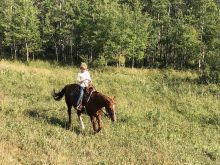As beef producers are always interested in finding ways to increase forage production and efficiency, the operators at Walter Farms near Camrose, Alta. are testing out an annual forage blend to help increase pasture carrying capacity.
Working with Graeme Finn of Union Forages they were impressed with a grass/legume blend called the Peace Diverse Mix.
Although it was customized a bit for Walter Farms, the blend included four types of forage brassica, forage sorghum, forage millet, Italian rye grass, 4010 peas, crimson clover, hairy vetch and a few oats and wheat. The hairy vetch and clover are annual legumes, the sorghum and millet are considered warm season forages, while the Italian rye is a cool season grass. The forage brassicas are different creatures — Winfred is a cross between kale and turnip, Hunter is a cross between turnip and Asiatic leaf vegetables, Corinne is an Ethiopian cabbage, and Graza is a fodder radish. All grow well in most of Western Canada.
Read Also

Harvest wraps up and fall work begins
At the Eppich famly ranch in western Saskatchewan, the fall harvest was successful with few breakdowns, cows and calves have been sorted and a new tractor has arrived
“With dry conditions, (about half the normal rainfall) it was actually a poorer growing season,” says Ed Lange, one of the farm owners. But with a bit of rain in July the pasture really took off. The 150 head of yearlings moved through the 50-acre seeding divided into five pastures (being moved every few days) three times during the summer and early fall, the farmers also cut about 10 tons of silage off part of the block during the late summer, and into October it was still growing.
“We actually could have run quite a few more yearlings but we didn’t know what to expect,” says Ed.
Ed says the Peace forage blend isn’t a cheap feed in terms of establishment, but it did greatly increase carrying capacity, put pounds on the yearlings, and also saved on the cost of trucking cattle to pasture. He estimates it cost about $75 per acre for the seeding. That included $28 per acre for the seed, $22 per acre for seeding costs with the drill, about $10 per acre for a pre-seeding glyphosate treatment and another $15 per acre to vertical till the field before seeding.
After a 50-acre trial with the blend in 2015, they plan to see 100 acres in 2016.















